A Two-Stage Distributionally Robust Optimization Model for Managing Electricity Consumption of Energy-Intensive Enterprises Considering Multiple Uncertainties
Abstract
:1. Introduction
- Most existing studies adopt a power grid-centric perspective when modeling the DR capabilities of energy-intensive enterprises (EIEs), relying primarily on macroscopic estimations of their response capacity during DR periods. These approaches often overlook the continuity constraints inherent in production processes, resulting in response strategies that lack integration with the actual operational workflows of the enterprises. Consequently, from the grid perspective, the authenticity of the DR capabilities of EIEs remains uncertain. Moreover, for EIE users, such methods do not maximize the economic benefits of their participation in DR programs.
- Many studies employ deterministic models. From an internal perspective, they often overlook the impact of uncertainties in the DG output on response strategies. From an external perspective, they may not consider the uncertainties associated with the DR signals issued by the power grid, further reducing the robustness and applicability of the proposed strategies. When such uncertainties occur under adverse scenarios, they can significantly undermine the economic efficiency of energy management for EIE users.
- The electricity consumption characteristics of EIEs are modeled in detail using the state task network (STN), specifically tailored to the features of process industries.
- A two-stage distributionally robust optimization (DRO) model is developed to address the uncertainty risks associated with DG output in EIEs. It incorporates both day-ahead pre-scheduling and intra-day rescheduling. Through rigorous mathematical transformations, the model is converted into an MILP problem, allowing it to be solved using commercial solvers (such as Gurobi), thereby improving its computational efficiency.
- The model considers the complex demand response signals from the grid, explicitly addressing the uncertainty in the awarded capacity during the intra-day period. Additionally, by simplifying the model, it is possible to calculate the DR potential of EIEs while considering their economic interests, providing valuable insights for the grid in implementing DR strategies.
2. Methodology
2.1. Overview
2.2. DG Output Prediction Model
- Obtain historical meteorological data, including irradiance, temperature, and wind speed, for the location of the photovoltaic power plant, along with the corresponding power output of the photovoltaic plant for each record.
- Data processing: specifically, the irradiance is adjusted to the effective irradiance of the photovoltaic panels, and the temperature is corrected to the effective temperature of the photovoltaic panels, thereby generating the modified meteorological data, which are corrected using the following formulas:In the equations, represents the effective irradiance of the photovoltaic panel, is the direct irradiance, is the diffuse irradiance, and is the total irradiance on the horizontal plane. is the tilt angle of the photovoltaic panel, is the solar incidence angle, and is the reflectivity coefficient. is the effective temperature of the photovoltaic panel, is the ambient temperature, is the solar irradiance, and is the temperature coefficient.
- Training: the corrected meteorological data is used as input to the neural network, with the corresponding photovoltaic power generation output for each set of meteorological data serving as the output. The neural network is then trained using these input–output pairs.
- Output: the corrected meteorological data are input into the trained neural network, and the network outputs the power generation of the photovoltaic power plant for the corresponding prediction period.
2.3. Production Process Modeling—State Task Network
2.4. Modeling of Multiple Uncertainties
2.4.1. Uncertainty in DG Output
2.4.2. Uncertainty of Awarded Capacity in DR
2.5. Two-Stage Distributionally Robust Optimization
2.5.1. Objective Function
- The cost of purchasing electricity from the grid throughout the day;
- The revenue generated from selling electricity produced by the user’s DGs;
- The penalty incurred for failing to meet the awarded DR capacity ();
- The subsidy revenue earned from participating in load reduction initiatives ().
2.5.2. Constraints
- Single Operational State for Task Nodes
- Material Balance
- Material Storage
- Target Output of Final Product
- Continuity of Operational Modes for Task Nodes
- Electricity Purchase or Sale
- Power Balance
2.6. Model Reconstruction and Transformation
2.6.1. Constraint Adjustment
- Electricity Purchase or Sale Adjustment
- Power Balance Adjustment
2.6.2. Probability Constraint Transformation
2.6.3. Transformation of DRO
3. Case Study
3.1. Parameters
3.2. Dataset
4. Results
4.1. Strategy Analysis
4.2. Comparison of Different Scenarios
- Scenario 1: No participation in intra-day invited DR.
- Scenario 2: Participation in intra-day invited DR from 10:00 to 12:00.
- Scenario 3: Participation in intra-day invited DR from 18:00 to 20:00.
4.3. DRO Algorithm Sensitivity Analysis
5. Discussion
6. Conclusions
- This study characterizes uncertainties in DG output and the awarded capacity of intra-day invited DR using a Wasserstein distance-based uncertainty set and probability constraints. It then formulates a two-stage DRO model for day-ahead and intra-day electricity planning in EIEs. Within the framework of the STN model, the proposed approach provides an economically efficient production electricity plan that satisfies the users’ demands while offering a detailed equipment operation schedule for EIE participation in DR.
- By varying the sample size of historical forecast errors, the DRO model effectively adjusts the radius of the Wasserstein ball, striking a balance between economic efficiency and robustness in the optimization solution. This approach leverages the capacity of stochastic optimization to incorporate expected risks based on historical data while benefiting from the strong robustness characteristics of robust optimization. The participation of EIEs in intra-day invited demand response results in substantial cost reductions, with the most significant effects observed during evening demand response periods.
- Across varying target production levels, the scheduling costs of the DRO model consistently lie between those of SO and RO. This shows that the proposed model effectively balances economic efficiency and robustness in different scenarios, highlighting its strong generalizability.
Author Contributions
Funding
Data Availability Statement
Conflicts of Interest
Abbreviations
| EIE | Energy-intensive enterprise |
| DR | Demand response |
| DG | Distributed generation |
| DSM | Demand-side management |
| STN | State task network |
| RTN | Resource task network |
| VRE | Variable renewable energy |
| PV | Photovoltaic |
| MILP | Mixed-integer linear programming |
| DRO | Distributionally robust optimization |
| SO | Stochastic optimization |
| RO | Robust optimization |
| CNY | Chinese Yuan |
References
- Impram, S.; Nese, S.V.; Oral, B. Challenges of renewable energy penetration on power system flexibility: A survey. Energy Strat. Rev. 2020, 31, 100539. [Google Scholar] [CrossRef]
- Liao, S.Y.; Xu, J.; Sun, Y.Z.; Bao, Y.; Tang, B.W. Control of Energy-Intensive Load for Power Smoothing in Wind Power Plants. IEEE Trans. Power Syst. 2018, 33, 6142–6154. [Google Scholar] [CrossRef]
- Xu, Q.; Lin, L.; Liang, Q.M. What influences industrial enterprises’ willingness of demand response: A survey in Qinghai, China. J. Clean. Prod. 2023, 428, 139483. [Google Scholar] [CrossRef]
- Chen, R.Z.; Sun, H.B.; Jin, H.Y. Pattern and benefit analysis of energy-intensive enterprises participating in power system dispatch. Autom. Electr. Power Syst. 2015, 39, 168–175. [Google Scholar]
- Liu, W.; Wen, J.; Xie, C.; Wang, W.; Liang, C. Multi-objective optimal method considering wind power accommodation based on source-load coordination. Proc. CSEE 2015, 35, 1079–1088. [Google Scholar]
- Choobineh, M.; Mohagheghi, S. Optimal energy management in an industrial plant using on-site generation and demand scheduling. IEEE Trans. Ind. Appl. 2015, 52, 1945–1952. [Google Scholar] [CrossRef]
- Huang, X.; Hong, S.H.; Li, Y. Hour-ahead price based energy management scheme for industrial facilities. IEEE Trans. Ind. Inform. 2017, 13, 2886–2898. [Google Scholar] [CrossRef]
- Maravelias, C.T.; Grossmann, I.E. New general continuous-time State—Task network formulation for short-term scheduling of multipurpose batch plants. Ind. Eng. Chem. Res. 2003, 42, 3056–3074. [Google Scholar] [CrossRef]
- Castro, P.M.; Sun, L.; Harjunkoski, I. Resource–task network formulations for industrial demand side management of a steel plant. Ind. Eng. Chem. Res. 2013, 52, 13046–13058. [Google Scholar] [CrossRef]
- Ma, X.; Pei, W.; Xiao, H.; Deng, W.; Xiao, H.; Sun, W. Integrated energy network and production management optimization operation of battery production industrial estate considering complex production constraints. Power Syst. Technol. 2018, 42, 3566–3575. [Google Scholar]
- Shi, J.; Wen, F.; Cui, P.; Sun, L.; Shang, J.; He, Y. Intelligent energy management of industrial loads considering participation in demand response program. Autom. Electr. Power Syst. 2017, 41, 45–53. [Google Scholar]
- Dileep, G. A survey on smart grid technologies and applications. Renew. Energy 2020, 146, 2589–2625. [Google Scholar] [CrossRef]
- Rahimian, H.; Mehrotra, S. Distributionally robust optimization: A review. arXiv 2019, arXiv:1908.05659. [Google Scholar]
- Huang, H.; Liang, R.; Lv, C.; Lu, M.; Gong, D.; Yin, S. Two-stage robust stochastic scheduling for energy recovery in coal mine integrated energy system. Appl. Energy 2021, 290, 116759. [Google Scholar] [CrossRef]
- Cao, Y.; Li, D.; Zhang, Y.; Tang, Q.; Khodaei, A.; Zhang, H.; Han, Z. Optimal energy management for multi-microgrid under a transactive energy framework with distributionally robust optimization. IEEE Trans. Smart Grid. 2021, 13, 599–612. [Google Scholar] [CrossRef]
- Notice on Issuing the “Basic Rules for the Electricity Spot Market (Trial)”. Available online: https://zfxxgk.ndrc.gov.cn (accessed on 7 September 2023).
- Andrade, J.R.; Bessa, R.J. Improving renewable energy forecasting with a grid of numerical weather predictions. IEEE Trans. Sustain. Energy 2017, 8, 1571–1580. [Google Scholar] [CrossRef]
- Panaretos, V.M.; Zemel, Y. Statistical aspects of Wasserstein distances. Annu. Rev. Stat. Appl. 2019, 6, 405–431. [Google Scholar] [CrossRef]
- Notice on Issuing the “Implementation Rules for Electric Power Demand Response in Jiangsu Province (Revised Edition)”. Available online: https://fzggw.jiangsu.gov.cn (accessed on 11 June 2018).
- Cherukuri, A.; Cortés, J. Cooperative data-driven distributionally robust optimization. IEEE Trans. Autom. Control 2019, 65, 4400–4407. [Google Scholar] [CrossRef]
- Wang, Y.; Yang, Y.; Fei, H.; Song, M.; Jia, M. Wasserstein and multivariate linear affine based distributionally robust optimization for CCHP-P2G scheduling considering multiple uncertainties. Appl. Energy 2022, 306, 118034. [Google Scholar] [CrossRef]
- Helton, J.C.; Davis, F.J. Latin hypercube sampling and the propagation of uncertainty in analyses of complex systems. Reliab. Eng. Syst. Saf. 2003, 81, 23–69. [Google Scholar] [CrossRef]
- Zhang, Y.; Song, S.; Shen, Z.-J.M.; Wu, C. Robust shortest path problem with distributional uncertainty. IEEE Trans. Intell. Transp. Syst. 2017, 19, 1080–1090. [Google Scholar] [CrossRef]
- Solar Power Generation. Available online: https://www.elia.be/en/grid-data (accessed on 10 July 2024).
- Duan, C.; Fang, W.; Jiang, L.; Yao, L.; Liu, J. Distributionally robust chance-constrained approximate AC-OPF with Wasserstein metric. IEEE Trans. Power Syst. 2018, 33, 4924–4936. [Google Scholar] [CrossRef]
- Nosratabadi, S.M.; Hooshmand, R.-A.; Gholipour, E. Stochastic profit-based scheduling of industrial virtual power plant using the best demand response strategy. Appl. Energy 2016, 164, 590–606. [Google Scholar] [CrossRef]
- Kong, X.; Xiao, J.; Liu, D.; Wu, J.; Wang, C.; Shen, Y. Robust stochastic optimal dispatching method of multi-energy virtual power plant considering multiple uncertainties. Appl. Energy 2020, 279, 115707. [Google Scholar] [CrossRef]
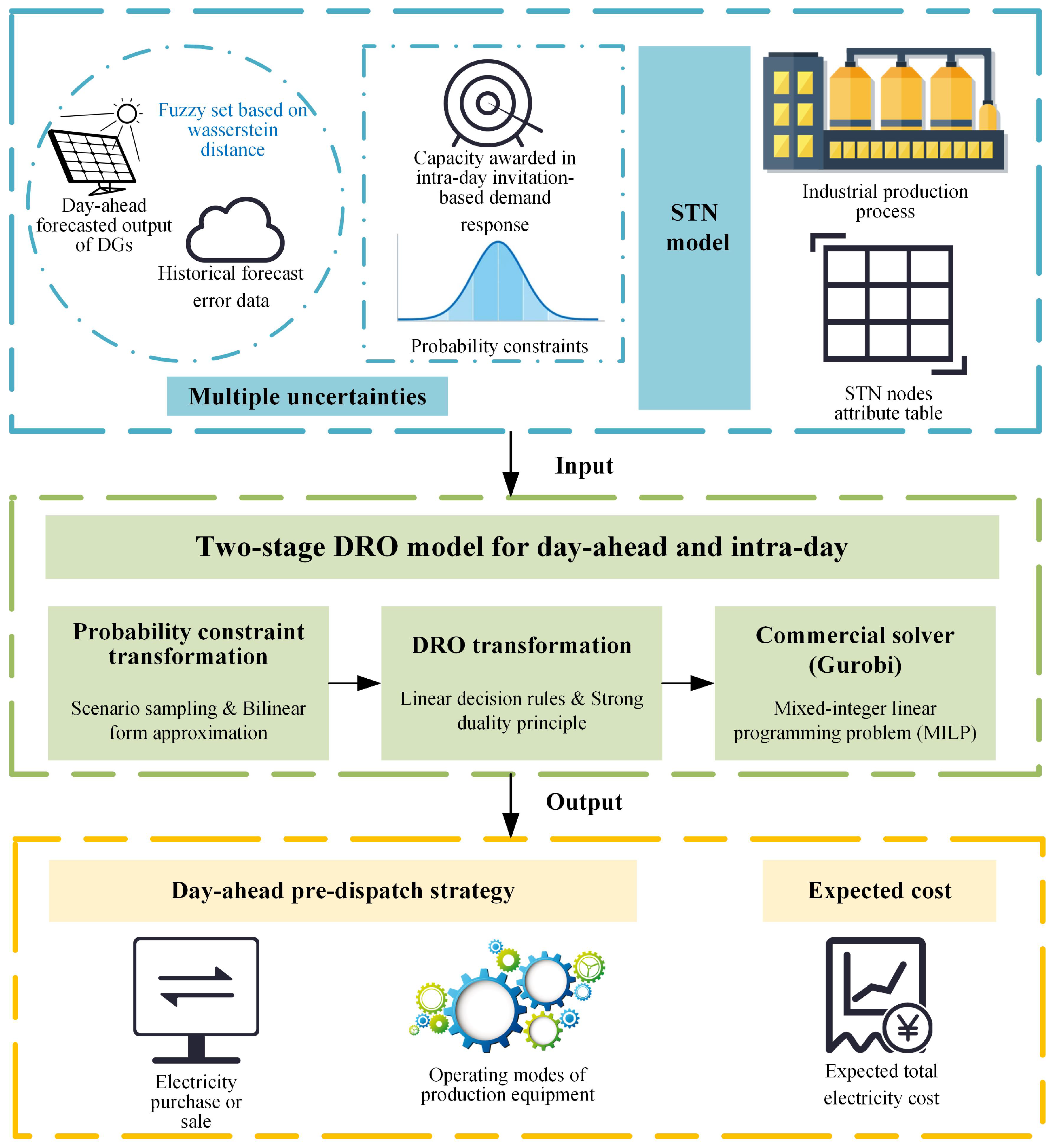
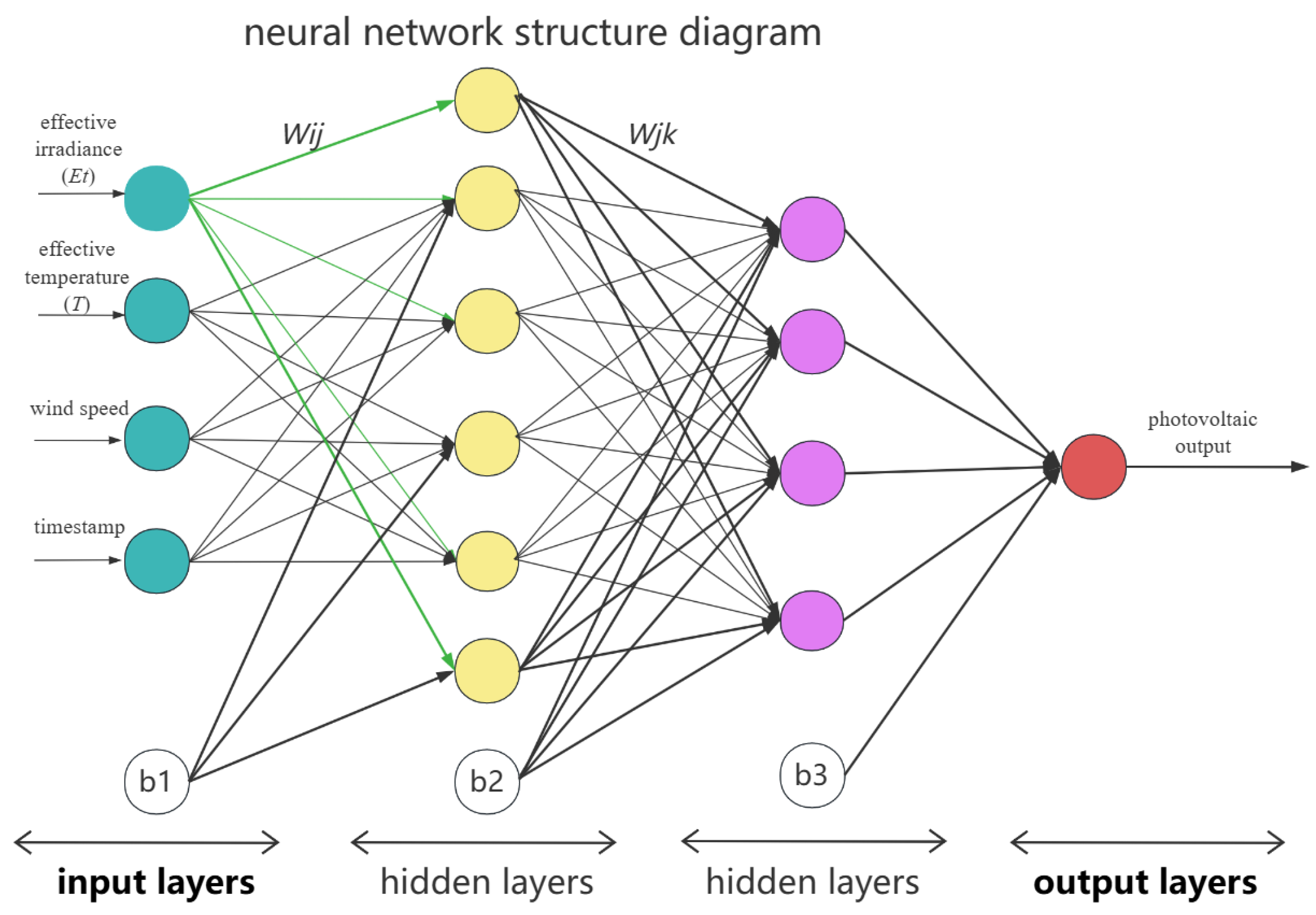

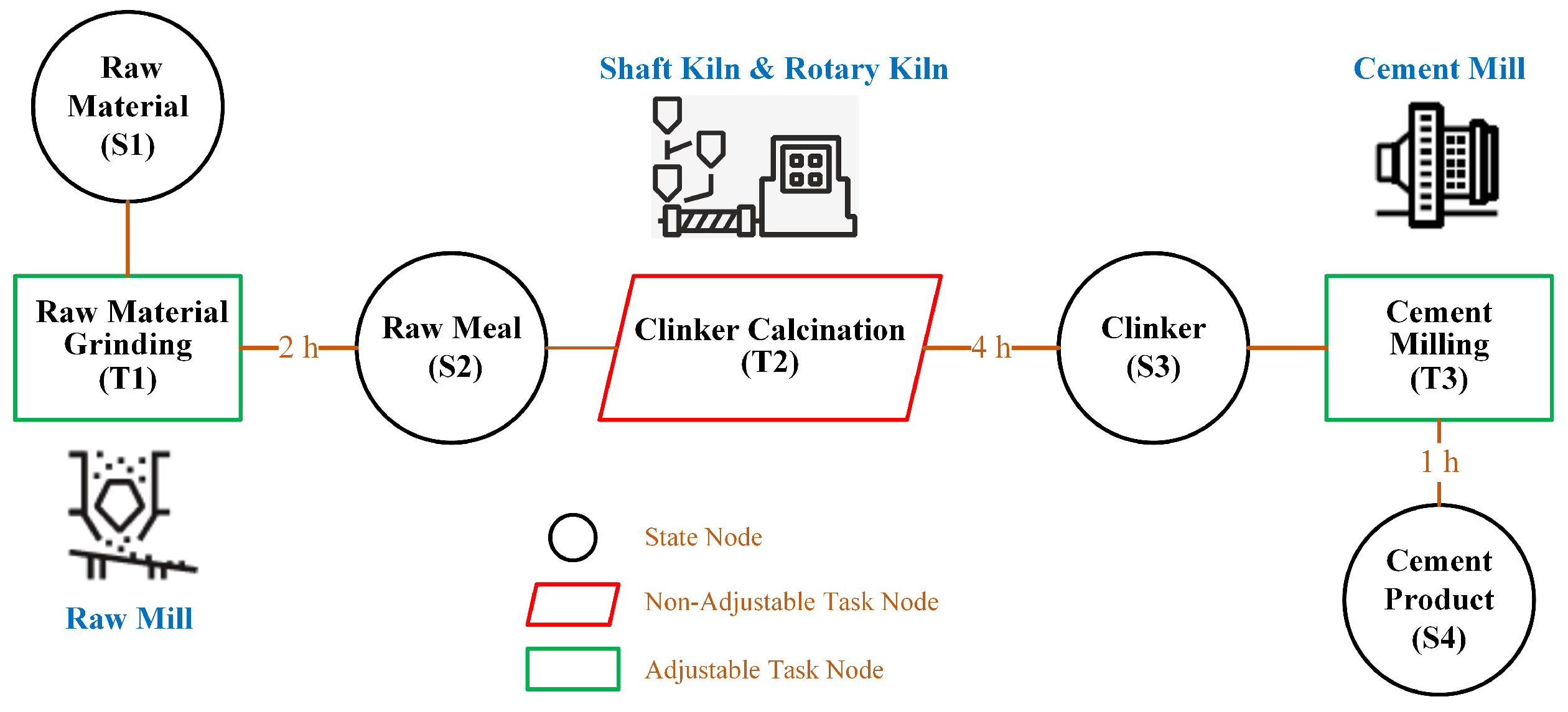
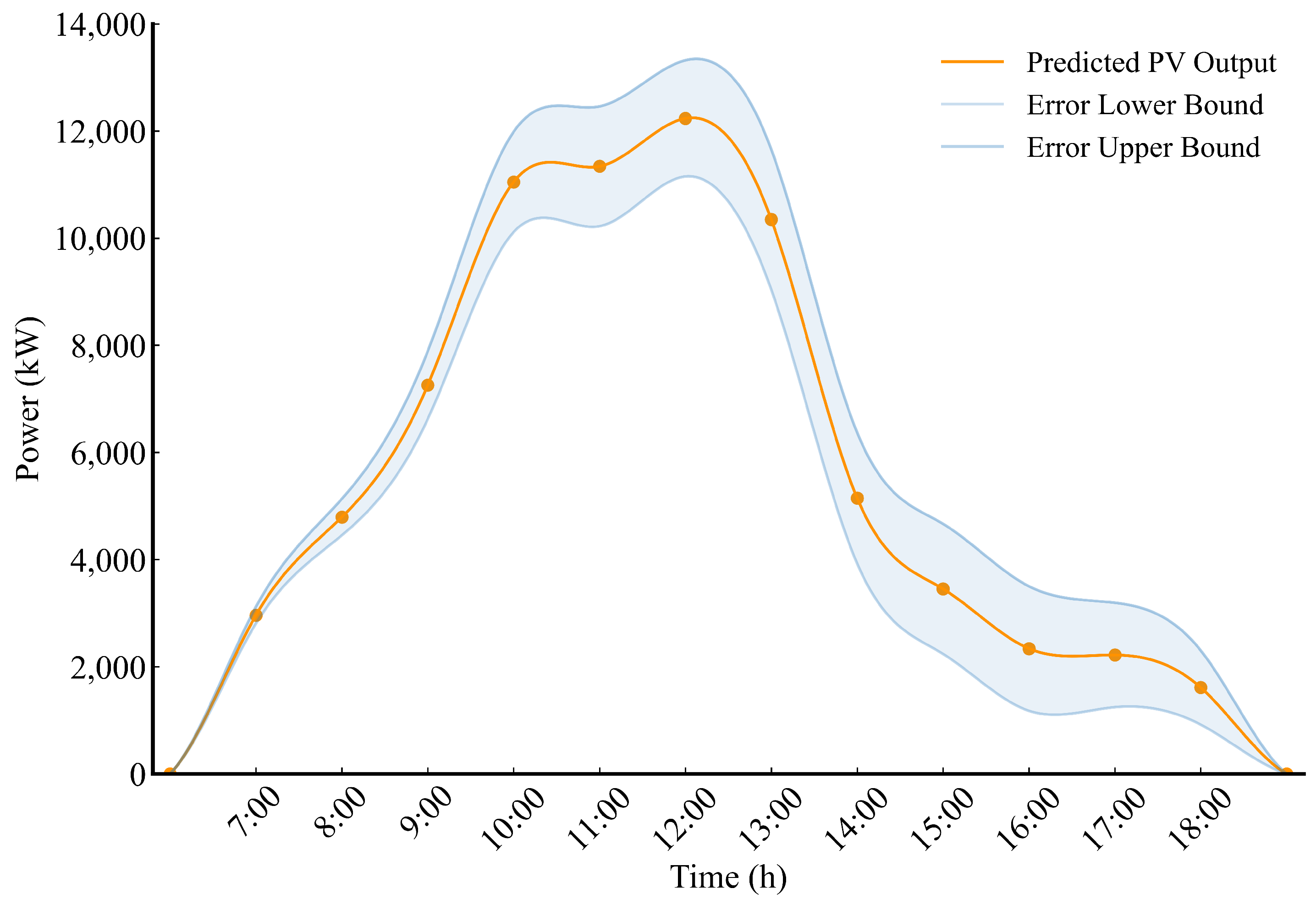
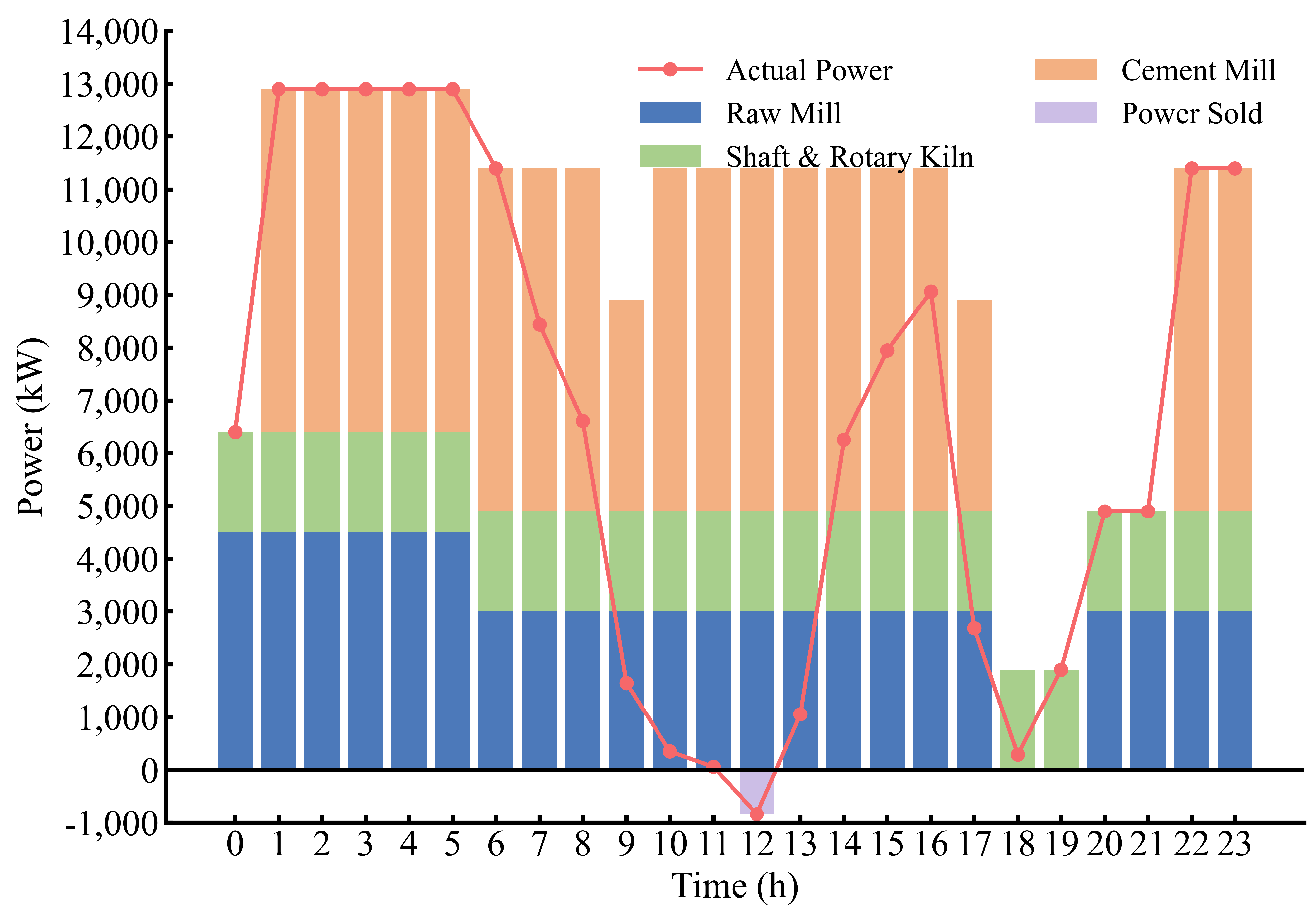
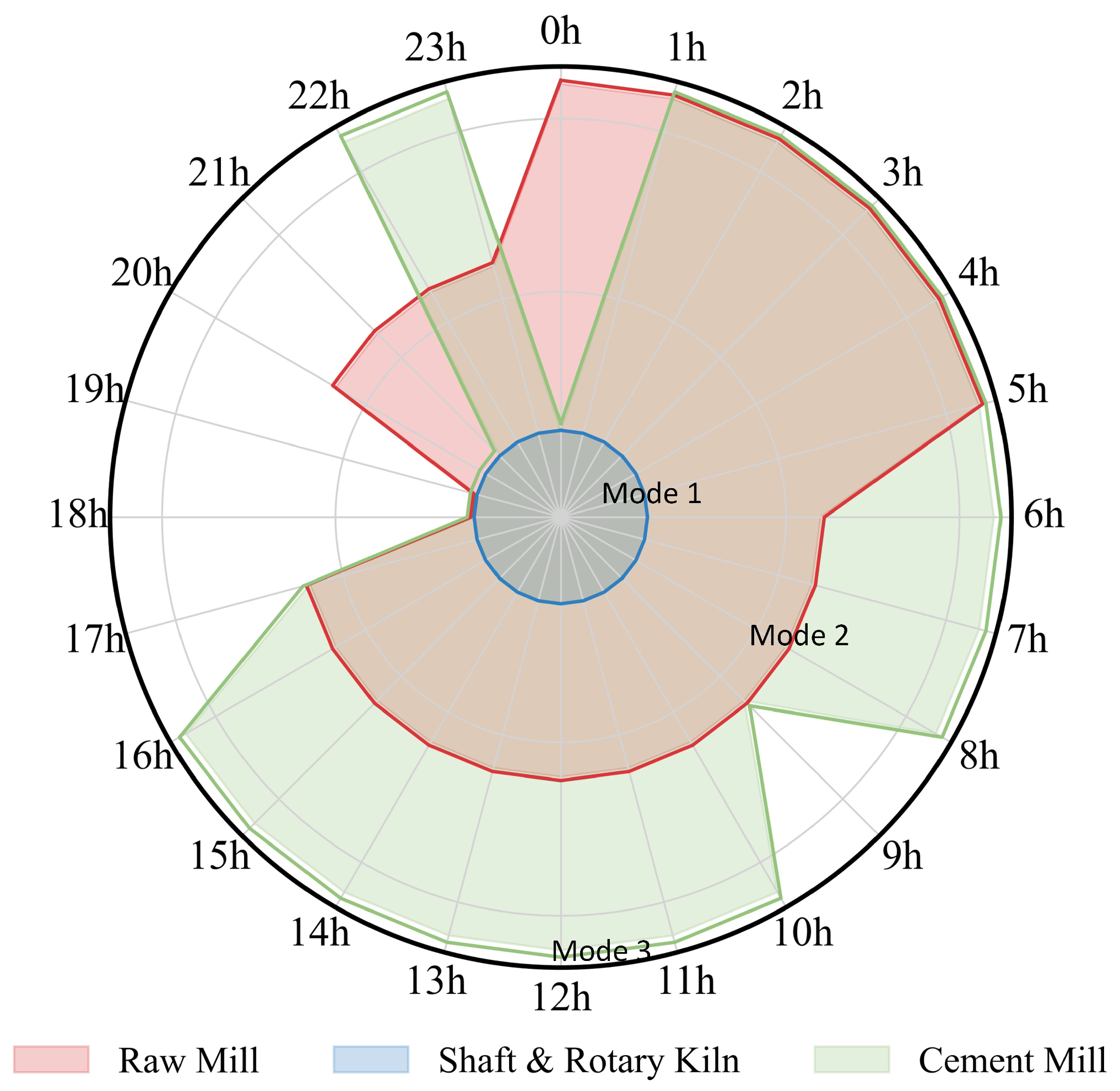
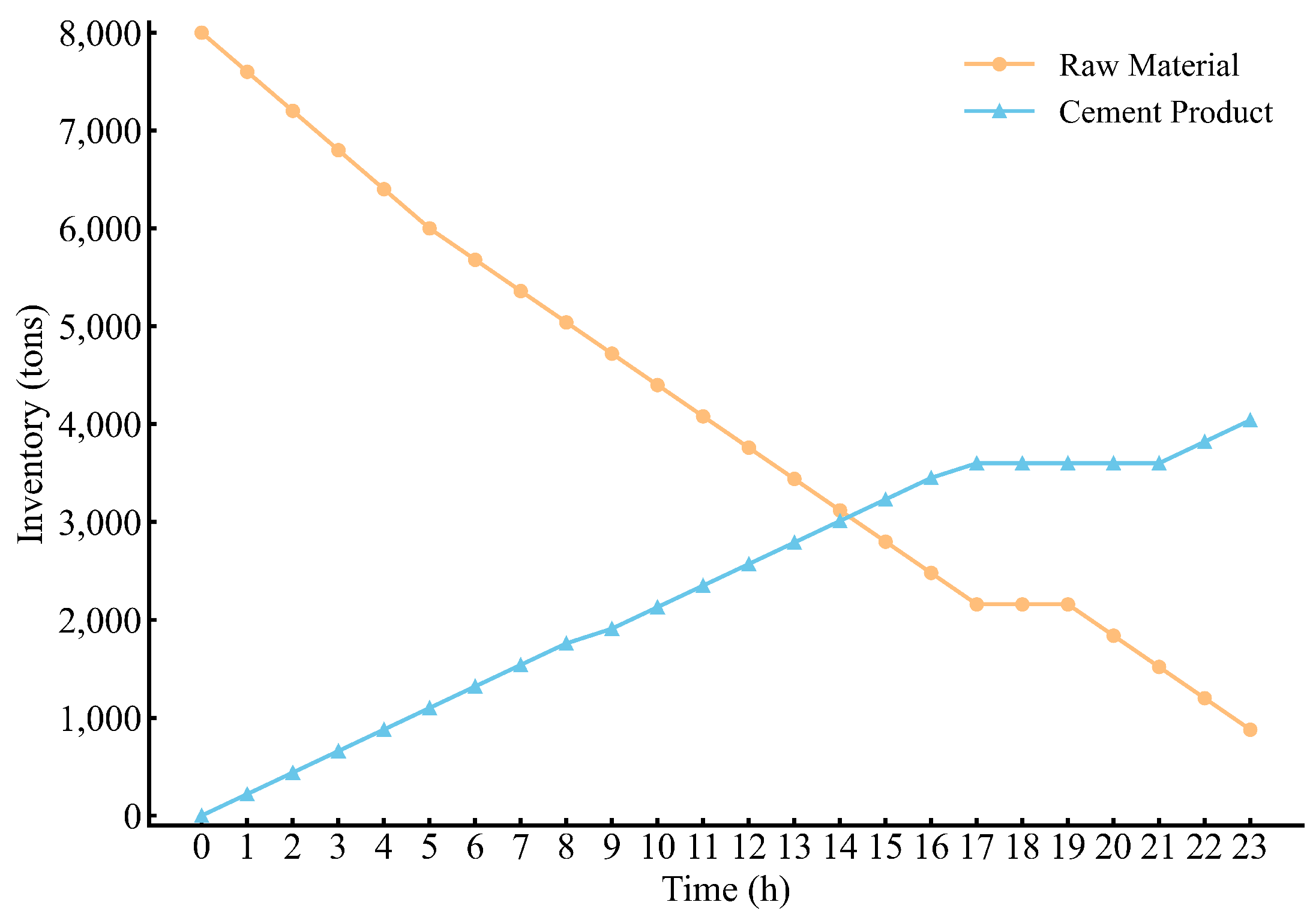
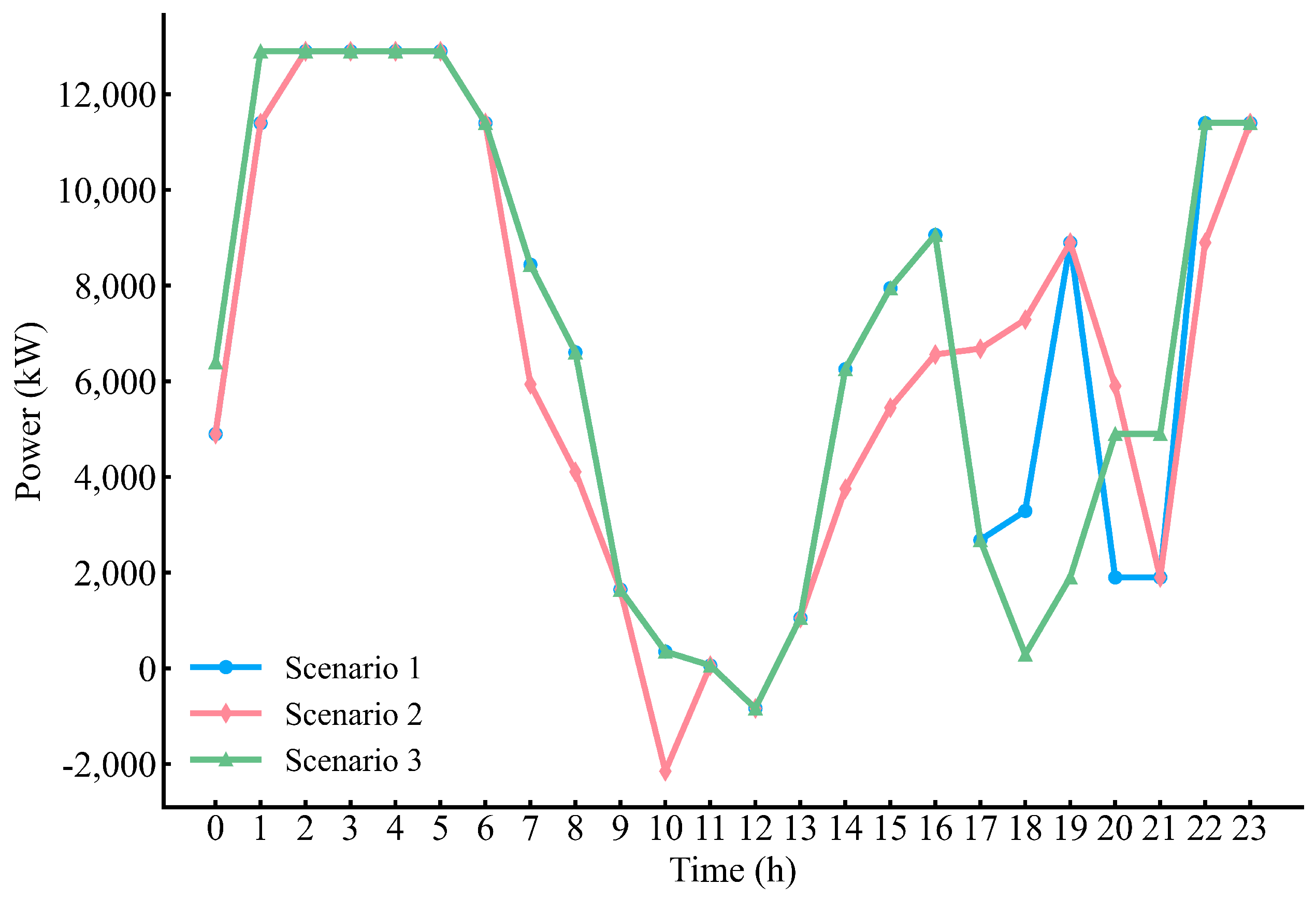
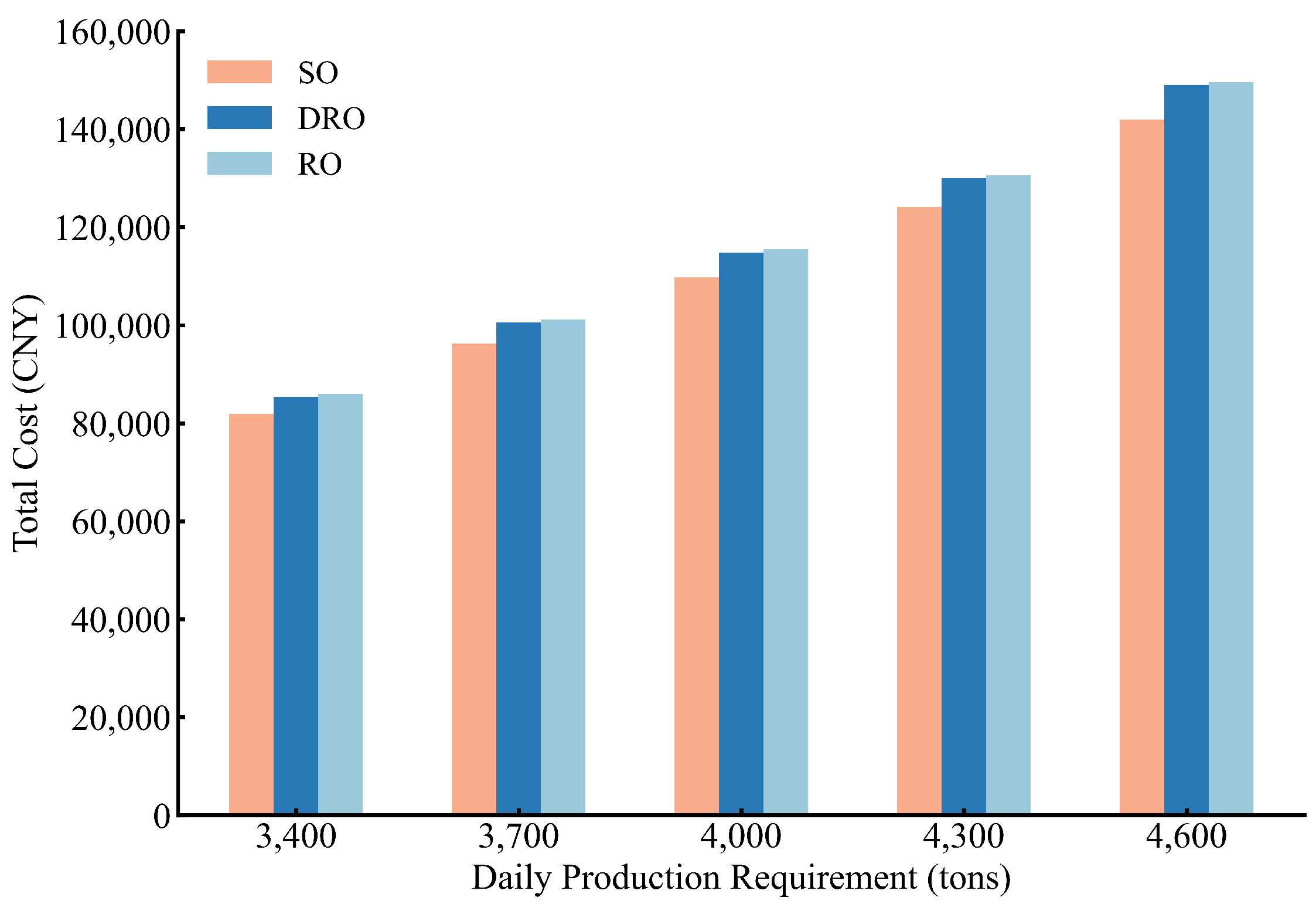
| Parameter | Value |
|---|---|
| Peak Hour 1 Purchase Electricity Price | 0.8248 CNY/kWh |
| Peak Hour Sale Electricity Price | 0.6186 CNY/kWh |
| Normal Hour 2 Purchase Electricity Price | 0.5499 CNY/kWh |
| Normal Hour Sale Electricity Price | 0.4124 CNY/kWh |
| Off-Peak Hour 3 Purchase Electricity Price | 0.2749 CNY/kWh |
| Off-Peak Hour Sale Electricity Price | 0.2062 CNY/kWh |
| Penalty Factor for Not Meeting DR Target | 4.0 CNY/kWh |
| Subsidy Rate for Load Reduction | 3.0 CNY/kWh |
| DR Threshold Ratios | 50%/70%/120% |
| DR Capacity Discount Factors | 60%/100%/120% |
| Installed Capacity of DGs | 14 MW |
| Upper Limits of Power Purchased | 15,000 kW |
| Upper Limits of Power Sold | 10,000 kW |
| Material * | Storage Upper Limit (tons) | Storage Lower Limit (tons) | Initial Value (tons) |
|---|---|---|---|
| S1 | 10,000 | 0 | 8000 |
| S2 | 2000 | 0 | 0 |
| S3 | 5000 | 0 | 0 |
| S4 | 10,000 | 0 | 0 |
| Task * | Operating Mode k | Material Consumption Rate (tons/h) | Product Output Rate (tons/h) | Power Consumption (kW) |
|---|---|---|---|---|
| 1 | 0 | 0 | 0 | |
| T1 | 2 | 320 | 300 | 3000 |
| 3 | 400 | 350 | 4500 | |
| T2 | 1 | 280 | 250 | 1900 |
| 1 | 0 | 0 | 0 | |
| T3 | 2 | 160 | 150 | 4000 |
| 3 | 240 | 220 | 6500 |
| Sample Size | Day-Ahead Pre-Dispatch Cost (CNY) | Intra-Day Re-Dispatch Cost (CNY) | Total Cost (CNY) | Solution Time (s) |
|---|---|---|---|---|
| 100 | 72,213 | 43,273 | 115,486 | 28.12 |
| 150 | 72,048 | 43,374 | 115,422 | 39.06 |
| 200 | 71,938 | 43,454 | 115,392 | 56.50 |
| 250 | 72,075 | 43,321 | 115,396 | 65.62 |
| 300 | 71,526 | 43,701 | 115,227 | 78.75 |
| 350 | 70,426 | 44,431 | 114,857 | 91.68 |
| Scenario ID | Day-Ahead Pre-Dispatch Cost (CNY) | Intra-Day Re-Dispatch Cost (CNY) | Total Cost (CNY) |
|---|---|---|---|
| 1 | 69,602 | 89,277 | 158,879 |
| 2 | 69,632 | 80,152 | 149,784 |
| 3 | 70,426 | 44,431 | 114,857 |
| Algorithm | SO (CNY) | DRO (CNY) | RO (CNY) |
|---|---|---|---|
| 3400 | 81,963 | 85,425 | 86,030 |
| 3700 | 96,239 | 100,587 | 101,206 |
| 4000 | 109,784 | 114,896 | 115,515 |
| 4300 | 124,106 | 130,067 | 130,692 |
| 4600 | 141,981 | 149,043 | 149,662 |
Disclaimer/Publisher’s Note: The statements, opinions and data contained in all publications are solely those of the individual author(s) and contributor(s) and not of MDPI and/or the editor(s). MDPI and/or the editor(s) disclaim responsibility for any injury to people or property resulting from any ideas, methods, instructions or products referred to in the content. |
© 2024 by the authors. Licensee MDPI, Basel, Switzerland. This article is an open access article distributed under the terms and conditions of the Creative Commons Attribution (CC BY) license (https://creativecommons.org/licenses/by/4.0/).
Share and Cite
Li, J.; Du, Z.; Yuan, L.; Huang, Y.; Liu, J. A Two-Stage Distributionally Robust Optimization Model for Managing Electricity Consumption of Energy-Intensive Enterprises Considering Multiple Uncertainties. Electronics 2024, 13, 5058. https://doi.org/10.3390/electronics13245058
Li J, Du Z, Yuan L, Huang Y, Liu J. A Two-Stage Distributionally Robust Optimization Model for Managing Electricity Consumption of Energy-Intensive Enterprises Considering Multiple Uncertainties. Electronics. 2024; 13(24):5058. https://doi.org/10.3390/electronics13245058
Chicago/Turabian StyleLi, Jiale, Zhaobin Du, Liao Yuan, Yuanping Huang, and Juan Liu. 2024. "A Two-Stage Distributionally Robust Optimization Model for Managing Electricity Consumption of Energy-Intensive Enterprises Considering Multiple Uncertainties" Electronics 13, no. 24: 5058. https://doi.org/10.3390/electronics13245058
APA StyleLi, J., Du, Z., Yuan, L., Huang, Y., & Liu, J. (2024). A Two-Stage Distributionally Robust Optimization Model for Managing Electricity Consumption of Energy-Intensive Enterprises Considering Multiple Uncertainties. Electronics, 13(24), 5058. https://doi.org/10.3390/electronics13245058





